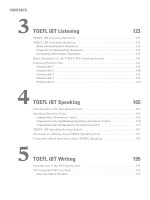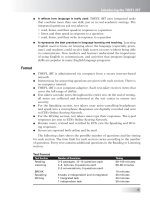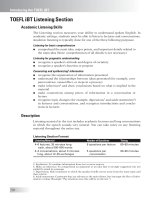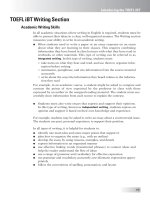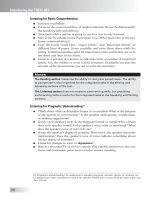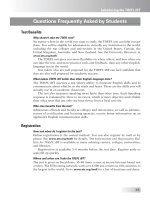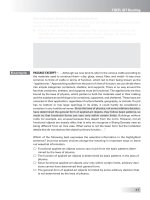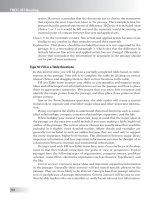Ebook Pocket guide to critical care pharmacotherapy (2nd edition): Part 1
Bạn đang xem bản rút gọn của tài liệu. Xem và tải ngay bản đầy đủ của tài liệu tại đây (407.99 KB, 100 trang )
John Papadopoulos
David R. Schwartz
Consulting Editor
Pocket Guide to Critical
Care Pharmacotherapy
Second Edition
123
Pocket Guide to Critical Care
Pharmacotherapy
John Papadopoulos
Author
David R. Schwartz
Consulting Editor
Pocket Guide
to Critical Care
Pharmacotherapy
Second Edition
Author
Consulting Editor
John Papadopoulos, B.S.,
Pharm.D., FCCM, BCNSP
Department of Pharmacy
New York University Langone
Medical Center
New York, NY, USA
David R. Schwartz, M.D.
Pulmonary and Critical Care
Division
Department of Medicine
New York University Langone
Medical Center
New York, NY, USA
ISBN 978-1-4939-1852-2
ISBN 978-1-4939-1853-9 (eBook)
DOI 10.1007/978-1-4939-1853-9
Springer New York Heidelberg Dordrecht London
Library of Congress Control Number: 2014953966
© Springer Science+Business Media New York 2008, 2015
This work is subject to copyright. All rights are reserved by the Publisher,
whether the whole or part of the material is concerned, specifically the rights of
translation, reprinting, reuse of illustrations, recitation, broadcasting, reproduction
on microfilms or in any other physical way, and transmission or information
storage and retrieval, electronic adaptation, computer software, or by similar or
dissimilar methodology now known or hereafter developed. Exempted from this
legal reservation are brief excerpts in connection with reviews or scholarly
analysis or material supplied specifically for the purpose of being entered and
executed on a computer system, for exclusive use by the purchaser of the work.
Duplication of this publication or parts thereof is permitted only under the
provisions of the Copyright Law of the Publisher’s location, in its current version,
and permission for use must always be obtained from Springer. Permissions for
use may be obtained through RightsLink at the Copyright Clearance Center.
Violations are liable to prosecution under the respective Copyright Law.
The use of general descriptive names, registered names, trademarks, service
marks, etc. in this publication does not imply, even in the absence of a specific
statement, that such names are exempt from the relevant protective laws and
regulations and therefore free for general use.
While the advice and information in this book are believed to be true and
accurate at the date of publication, neither the authors nor the editors nor the
publisher can accept any legal responsibility for any errors or omissions that may
be made. The publisher makes no warranty, express or implied, with respect to
the material contained herein.
Printed on acid-free paper
Springer is part of Springer Science+Business Media (www.springer.com)
This handbook is dedicated
to my wife, Maria,
my children, Theodore
Thomas, Eleni Thalia,
and Pantelia “Lia” Zoe, and
my mother, Eleni.
I am grateful for your
collective understanding
of my professional
commitment.
John Papadopoulos
Preface
Critical care medicine is a cutting-edge medical field that is
highly evidence-based. Studies are continuously published
that alter the approach to patient care. As a critical care clinician, I am aware of the tremendous commitment required to
provide optimal evidence-based care. Pocket Guide to Critical
Care Pharmacotherapy covers the most common ailments
observed in critically ill adult patients. I utilize an algorithmic,
easy-to-follow, systematic approach. Additionally, I provide
references and web links for many disease states, for clinicians
who want to review the available literature in greater detail.
The contents of this handbook should be utilized as a
guide and in addition to sound clinical judgment. Consult full
prescribing information and take into consideration each
drug’s pharmacokinetic profile, contraindications, warnings,
precautions, adverse reactions, potential drug interactions,
and monitoring parameters before use.
Every effort was made to ensure the accuracy of Pocket
Guide to Critical Care Pharmacotherapy. The author, consulting editor, and publisher are not responsible for errors or
omissions or for any consequences associated with the utilization of the contents of this handbook.
New York, NY, USA
John Papadopoulos, BS, PharmD,
FCCM, BCNSP
vii
Contents
1
Advance Cardiac Life Support ..................................
1
2
Cardiovascular .............................................................
19
3
Cerebrovascular ...........................................................
51
4
Critical Care .................................................................
59
5
Dermatology ................................................................
85
6
Endocrinology ..............................................................
87
7
Gastrointestinal............................................................
91
8
Hematology ..................................................................
99
9
Infectious Diseases ...................................................... 105
10
Neurology ..................................................................... 109
11
Nutrition ....................................................................... 113
12
Psychiatric Disorders .................................................. 119
13
Pulmonary .................................................................... 125
14
Renal ............................................................................. 131
Index...................................................................................... 155
ix
List of Tables
Table 1.1
Table 1.2
Table 1.3
Table 1.4
Table 1.5
Table 1.6
Table 1.7
Table 1.8
Table 1.9
Table 1.10
Table 1.11
Table 1.12
Table 1.13
ACLS pulseless arrest algorithm .................
Ventricular fibrillation/pulseless
ventricular tachycardia algorithm ...............
Pulseless electrical activity algorithm .........
Asystole algorithm ........................................
Bradycardia algorithm (slow [heart rate
< 50/min] or relatively slow) ........................
Tachycardia algorithm overview
(heart rate > 100/min) ....................................
Management of stable atrial
fibrillation/atrial flutter ................................
Management of narrow complex stable
supraventricular tachycardia
(QRS < 0.12 s) ................................................
Management of stable ventricular
tachycardia .....................................................
Synchronized cardioversion
algorithm for the management
of symptomatic tachycardia .........................
Common drugs utilized during ACLS ........
Pulseless electrical activity: causes
(HATCH H2MO ppH)
and management ...........................................
Pharmacological management
of anaphylaxis/anaphylactoid reactions......
1
2
3
3
4
4
5
7
8
9
11
16
17
xi
xii
List of Tables
Table 2.1
Table 2.2
Table 2.3
Table 2.4
Table 2.5
Table 2.6
Table 2.7
Table 2.8
Table 2.9
Table 2.10
Table 2.11
Table 2.12
Table 2.13
Table 2.14
Table 2.15
Thrombolysis in myocardial infarction
(TIMI) grade flows .......................................
TIMI risk score for STEMI .........................
Acute pharmacological management
of unstable angina and non-ST elevation
myocardial infarction with an initial
invasive angiographic strategy .....................
Acute pharmacological management
of ST-elevation myocardial infarction
(noninvasive or conservative strategy) .......
Considerations in patients with right
ventricular infarctions ...................................
Contraindications to fibrinolytic
therapy in patients with ST-elevation
myocardial infarction ....................................
Management of acute decompensated
heart failure....................................................
Vaughan Williams classification
of antiarrhythmics .........................................
Antithrombotic pharmacotherapy
for patients with new onset atrial
fibrillation .......................................................
Causes and management of acquired
torsades de pointes........................................
Hypertensive crises .......................................
Management of catecholamine/
vasopressin extravasation .............................
Prevention of venous thromboembolism
in the medical intensive care
unit patient .....................................................
Acute management of a deep-vein
thrombosis or pulmonary embolism ...........
Management of an elevated
international normalized ratio (INR)
in patients receiving warfarin
pharmacotherapy ..........................................
19
19
20
25
34
34
35
37
38
39
41
43
44
45
48
List of Tables
Table 3.1
Table 3.2
Table 3.3
Table 3.4
Table 3.5
Table 3.6
Table 3.7
Table 4.1
Table 4.2
Table 4.3
Table 4.4
Table 4.5
Table 4.6
Table 4.7
Table 4.8
Table 4.9
Table 4.10
General supportive care for patients
with an acute cerebrovascular accident......
Blood pressure management
in the setting of an acute cerebrovascular
accident ...........................................................
Alteplase inclusion and exclusion
criteria for cerebrovascular accident
indication ........................................................
Modified National Institute
of Health Stroke Scale..................................
Alteplase administration protocol
for cerebrovascular accident indication .....
Management of an alteplase-induced
intracranial hemorrhage ...............................
Management of intracranial hypertension
(intracranial pressure ≥ 20 mmHg) .............
General drug utilization principles
in intensive care .............................................
Management of severe sepsis
and septic shock ............................................
Pain, agitation, and delirium guidelines .....
Riker sedation-agitation scale .....................
Confusion assessment method
for the diagnosis of delirium in intensive
care unit patients ...........................................
Neuromuscular blocker use
in the intensive care unit ..............................
Reversal of nondepolarizing
neuromuscular blockers ...............................
Factors that alter the effects
of neuromuscular blockers ...........................
Management of malignant
hyperthermia..................................................
Use of packed red blood cell transfusions
in critically ill patients...................................
xiii
51
52
53
54
56
57
57
59
60
63
66
66
68
69
70
71
72
xiv
List of Tables
Table 4.11
Table 4.12
Table 4.13
Table 4.14
Table 4.15
Table 4.16
Propylene glycol content of commonly
utilized intravenous medications .................
Drug-induced fever .......................................
Pharmaceutical dosage forms that should
not be crushed ...............................................
Stress-related mucosal damage
prophylaxis protocol .....................................
Therapeutic drug monitoring.......................
Select antidotes for toxicological
emergencies....................................................
Table 5.1
Drug-induced dermatological reactions .....
Table 6.1
Management of diabetic ketoacidosis
and hyperosmolar hyperglycemic state ......
Management of thyrotoxic crisis
and myxedema coma ....................................
Table 6.2
Table 7.1
Table 7.2
Table 7.3
Table 7.4
Table 7.5
Table 8.1
Table 8.2
Table 8.3
Table 9.1
Table 9.2
Table 9.3
Table 9.4
Management of acute non-variceal
upper gastrointestinal bleeding ...................
Causes of diarrhea in the intensive care
unit patient .....................................................
Managing the complications of cirrhosis....
Drug-induced hepatotoxicity .......................
Drug-induced pancreatitis............................
73
74
75
75
77
79
85
87
89
91
92
93
97
97
Drug-induced hematological disorders ...... 99
Management of heparin-induced
thrombocytopenia ......................................... 100
Management of methemoglobinemia ......... 102
Common causes of fever in intensive
care unit patients ...........................................
Prevention of hospital-acquired
and ventilator-associated pneumonia .........
Management of hospital-acquired and
ventilator-associated pneumonia .................
Clinical pulmonary infection score
(CPIS) calculation .........................................
105
105
106
108
List of Tables
Table 10.1
Table 10.2
Table 11.1
Table 11.2
Table 11.3
Table 11.4
xv
Management of convulsive status
epilepticus ...................................................... 109
Medications that may exacerbate
weakness in myasthenia gravis .................... 112
Nutrition assessment .....................................
Principles of parenteral nutrition ................
Select drug–nutrient interactions ................
Strategies to minimize aspiration
of gastric contents during enteral
nutrition ..........................................................
113
116
117
118
Table 12.1
Table 12.2
Table 12.3
Management of alcohol withdrawal ........... 119
Management of serotonin syndrome .......... 121
Management of neuroleptic malignant
syndrome ........................................................ 122
Table 13.1
Management of chronic obstructive
pulmonary disease ......................................... 125
Management of acute asthma
exacerbations ................................................. 127
Drug-induced pulmonary diseases .............. 129
Table 13.2
Table 13.3
Table 14.1
Table 14.2
Table 14.3
Table 14.4
Table 14.5
Table 14.6
Table 14.7
Table 14.8
Table 14.9
Contrast-induced nephropathy
prevention strategy .......................................
Pharmacological management
of acute kidney injury ...................................
Management of acute uremic bleeding ......
Drug-induced renal diseases ........................
Management of acute hypocalcemia
(serum calcium < 8.5 mg/dL) ........................
Management of acute hypercalcemia
(serum calcium > 12 mg/dL) .........................
Management of acute hypokalemia
(serum potassium < 3.5 mEq/L) ..................
Management of acute hyperkalemia
(serum potassium ≥ 5.5 mEq/L) ..................
Management of acute hypomagnesemia
(serum magnesium < 1.4 mEq/L) ................
131
133
134
135
136
137
138
139
141
xvi
List of Tables
Table 14.10
Table 14.11
Table 14.12
Table 14.13
Table 14.14
Table 14.15
Table 14.16
Management of acute hypermagnesemia
(serum magnesium > 2 mEq/L) .................
Management of acute hyponatremia
(serum sodium < 135 mEq/L) ....................
Management of acute hypernatremia
(serum sodium > 145 mEq/L) ....................
Management of acute
hypophosphatemia (<2 mg/dL) .................
Management of hyperphosphatemia
(>5 mg/dL) ...................................................
Management of acute primary
metabolic acidosis (pH < 7.35) ...................
Management of acute primary
metabolic alkalosis (pH > 7.45) ..................
141
142
146
148
148
149
152
Chapter 1
Advance Cardiac Life
Support
Table 1.1 ACLS pulseless arrest algorithm
•
Basic life support (BLS) algorithm—emphasis on maintaining cardiac/
cerebral perfusion through early, high-quality chest compressions
with minimal interruption, rapid defibrillation when appropriate,
and avoiding delays in establishing a definitive airway and excessive
ventilation. Use of vasopressors and antiarrhythmic agents is
deemphasized
○
Check the carotid pulse for 5–10 s
○
If no pulse within 10 s, start high-quality cardiopulmonary
resuscitation (CPR) with chest compressions
○
Push hard and fast (at least 100 compressions/min) at a depth of at
least 2 in.
○
Allow full chest recoil after each compression
○
Minimize interruptions in CPR (any interruption > 10 s) including
pulse checks
○
One CPR cycle is equal to 30 compressions then two breaths (30:2)
■
Five cycles administered every 2 min
■
If possible, compressor should change every 2 min
○
Avoid excessive ventilation leading to harmful elevations in
intrathoracic pressure
○
Continuous chest compressions with advanced airway. Administer
8–10 breaths per minute for cardiac arrest or 10–12 breaths per
minute for respiratory arrest, and check rhythm every 2 min
○
The AHA recommends continuous waveform capnography (in
addition to bedside assessment) as the most reliable method of
confirming correct endotracheal tube placement
■
End tidal CO2 (PETCO2) less than 10 mmHg indicates poor
blood flow and unlikely return of spontaneous circulation
(ROSC); improvement in CPR quality is advised
(continued)
J. Papadopoulos, Pocket Guide to Critical Care
Pharmacotherapy, DOI 10.1007/978-1-4939-1853-9_1,
© Springer Science+Business Media New York 2015
1
2
1
Advance Cardiac Life Support
Table 1.1 (continued)
■
•
•
•
•
A sustained abrupt rise in PETCO2 (especially to normal values
of 35–40 mmHg or greater) is usually indicative of ROSC and a
rhythm/pulse check is advisable
○
If intra-arterial diastolic pressure is less than 20 mmHg, then attempt
to improve CPR quality
ROSC—pulse/BP, PETCO2 greater than 40 mmHg, spontaneous waves
if using arterial line
Give oxygen when available
Attach defibrillator/monitor as soon as possible
Assess rhythm → shockable rhythm?
○
Ventricular fibrillation/pulseless ventricular tachycardia (shock
advised)—proceed to Table 1.2
○
Pulseless electrical activity (no shock)—proceed to Table 1.3
○
Asystole (no shock)—proceed to Table 1.4
Data from Circulation. 2010;122:S640–S65
Table 1.2 Ventricular fibrillation/pulseless ventricular tachycardia algorithm
• Basic life support (BLS) algorithm → give high-quality cardiopulmonary
resuscitation (CPR) stopping only for shock delivery, brief rhythm
checks, brief pulse checks if organized rhythm, and to facilitate
placement of an advanced airway
• Give oxygen
• Give one unsynchronized shock
○
Biphasic (device specific): 120–200 J (if unknown use 200 J)
○
Monophasic: 360 J
• Immediately after the shock, resume CPR for five cycles (about 2 min)
• When vascular access established (intact PVL > emergent PVL,
interosseous [IO] access > emergent CVL), administer vasopressor
during CPR (before or after the shock)
○
Epinephrine 1 mg intravenous push (IVP) or IO, repeat every
3–5 min
○
Vasopressin 40 units IVP/IO × one dose only, may replace the first or
second dose of epinephrine
• Check rhythm after five cycles (about 2 min) of CPR. Shockable
rhythm—repeat shock using equivalent or higher energy
• Resume CPR immediately after the shock
○
Consider antiarrhythmics (before or after the shock)
■
Amiodarone 300 mg IVP/IO × one dose (first-line agent)
□
May administer one repeat dose of 150 mg IVP/IO in 3–5 min
■
Lidocaine 1–1.5 mg/kg IVP/IO × one dose, then 0.5–0.75 mg/kg
IV every 5–10 min to a maximum of 3 mg/kg. May consider if
amiodarone is not available
■
Magnesium 1–2 g in 10 mL of D5W IVP/IO over 5 min for
torsades de pointes or severe hypomagnesemia
(continued)
1
Advance Cardiac Life Support
3
Table 1.2 (continued)
•
•
•
Resume CPR immediately for five cycles (about 2 min)
Repeat cycles of shock (if persistent VF/pulseless VT) and epinephrine
administration as aforementioned every 3–5 min
If ROSC, then proceed with post-cardiac arrest care
Data from Circulation. 2010;122:S640–S65
Table 1.3 Pulseless electrical activity algorithm
•
•
•
•
•
•
•
Review most frequent causes (see Table 1.12). Hypovolemia and
hypoxia are the two most common causes of PEA arrest
Basic life support (BLS) algorithm → give high-quality cardiopulmonary
resuscitation (CPR)
Epinephrine 1 mg intravenous push (IVP) or intraosseous (IO), repeat
every 3–5 min
Vasopressin 40 units IVP/IO × one dose only, may replace the first or
second dose of epinephrine
Check rhythm after five cycles (about 2 min) of CPR. If shockable
rhythm then proceed with the VF/VT algorithm in Table 1.2
The AHA has removed atropine from the 2010 guidelines, as it is
unlikely to have a therapeutic benefit
If ROSC, then proceed with post-cardiac arrest care
Table 1.4 Asystole algorithm
• Validate the rhythm (look for loose leads, low signal, loss of power)
• Identify and correct an underlying cause if present
• Basic life support (BLS) algorithm → give high-quality cardiopulmonary
resuscitation (CPR)
• Epinephrine 1 mg intravenous push (IVP) or intraosseous (IO), repeat
every 3–5 min
• Vasopressin 40 units IVP/IO × one dose only, may replace the first or
second dose of epinephrine
• Check rhythm after five cycles (about 2 min) of CPR. If shockable
rhythm then proceed with the VF/VT algorithm in Table 1.2
• The AHA has removed atropine from the 2010 guidelines, as it is
unlikely to have a therapeutic benefit
• The AHA recommends against attempted pacing in the 2010 guidelines,
as it is unlikely to have a therapeutic benefit
• An initial defibrillation may be warranted if it is unclear if the rhythm is
fine VF or asystole
• If ROSC, then proceed with post-cardiac arrest care
4
1
Advance Cardiac Life Support
Table 1.5 Bradycardia algorithm (slow [heart rate < 50/min] or relatively
slow)
• Assess airway, breathing, and signs/symptoms of bradycardia
• Give oxygen if hypoxemic (maintain oxygen saturation ≥ 94 %)
• Monitor blood pressure, pulse oximetry, and establish IV access
• Obtain and review 12-lead electrocardiogram (ECG)
• Consider causes and differential diagnosis
Serious signs or symptoms owing to bradycardia are present
• Atropine 0.5 mg intravenous push (IVP) every 3–5 min up to a total of
0.04 mg/kg or 3 mg total
○
Administer every 3 min in urgent circumstances
○
Use 1 mg doses in obese patients to avoid paradoxical bradycardia
○
Will not work in denervated transplanted hearts
• Transcutaneous pacing: provide analgesia and/or sedation if benefit
outweighs any risk; set the demand rate to 60 beats/min; set the current
milliamperes output to 2 mA above the current at which consistent
electrical and mechanical capture is achieved
• Dopamine continuous IV infusion 2–10 mcg/kg/min
• Epinephrine continuous IV infusion 2–10 mcg/min
• Consider glucagon 2–10 mg IV bolus followed by a 2–10 mg/h
continuous IV infusion in β-adrenergic blocker or calcium channel
blocker-induced bradycardia not responsive to atropine
• Prepare for possible transvenous pacing if the above measures are
ineffective
Table 1.6 Tachycardia algorithm overview (heart rate > 100/min)
Evaluate patient
• Assess airway, breathing, and signs/symptoms of tachycardia
• Give oxygen if hypoxemic (maintain oxygen saturation ≥ 94 %)
• Establish IV access
• Obtain 12-lead electrocardiogram (ECG)
• Identify and treat etiology
• Questions to address:
○
Is the patient unstable or stable?
○
Are there serious signs or symptoms as a result of the tachycardia?
■
Including hypotension, hypoperfusion, heart failure, angina,
pre-syncope/syncope, acute dyspnea, or hypoxemia
■
Ventricular rates less than 150/min rarely are responsible for
serious signs or symptoms
○
Is the rhythm regular or irregular?
○
Is the QRS complex narrow or wide? What is the morphology if
wide?
(continued)
1
Advance Cardiac Life Support
5
Table 1.6 (continued)
Unstable patient (serious signs or symptoms)
• Prepare for immediate synchronized cardioversion (see Table 1.10)
Stable patient (no serious signs or symptoms as a result of the tachycardia)
• Atrial fibrillation/atrial flutter
○
Evaluate
■
Cardiac function (i.e., can the patient tolerate negative inotropic
medications?)
■
Suspicion or known of Wolff–Parkinson–White Syndrome
(WPW)
■
Duration (less than or greater than 48 h)
○
See atrial fibrillation/atrial flutter algorithm (Table 1.7)
■
Rate control
■
Rhythm control
■
Consider early anticoagulation
• Narrow-complex tachycardias (QRS < 0.12 s)
○
See Table 1.8
• Stable wide-complex tachycardia with a regular rhythm
○
If ventricular tachycardia or uncertain rhythm (see Table 1.9)
○
If SVT with aberrancy, give adenosine (see Table 1.8)
• Stable wide-complex tachycardia with an irregular rhythm
○
If atrial fibrillation with aberrancy (see Table 1.7)
○
If atrial fibrillation with WPW (see Table 1.7)
○
If polymorphic ventricular tachycardia (see Table 1.9)
Table 1.7 Management of stable atrial fibrillation/atrial flutter
Normal
cardiac
function
EF < 40 %
Rate control
• β-adrenergic blockers
• Diltiazem
• Verapamil
•
•
Digoxin
Diltiazem
(with caution)
• Esmolol (with caution)
• Amiodarone
Rhythm control
(duration ≤ 48 h)
• Consider synchronized
cardioversion or
• Amiodarone
• Ibutilide
• Flecainide
• Propafenone
• Procainamide
• Consider synchronized
cardioversion or
• Amiodarone
(continued)
6
1
Advance Cardiac Life Support
Table 1.7 (continued)
WPW
Rate control
• Synchronized
cardioversion or
• Amiodarone
• Flecainide
• Procainamide
• Propafenone
• Sotalol
Rhythm control
(duration ≤ 48 h)
• Synchronized
cardioversion or
• Amiodarone
• Flecainide
• Procainamide
• Propafenone
• Sotalol
Avoid!
• Adenosine
• β-adrenergic blockers
• Calcium channel blockers
• Digoxin
EF Ejection fraction, WPW Wolff–Parkinson–White syndrome
Notes:
Use only one medication initially for rate or rhythm control (endpoint = desired goal, maximum advisable total dose given, or untoward side
effects). When utilizing both IV and enteral drug delivery, be aware of onset/
duration of action to avoid excessive dosing leading to hypotension and/or
bradycardia. Occasionally, two agents may need to be utilized; combination
therapy with a calcium channel blocker + β-adrenergic blocker may increase
the incidence of hypotension and bradycardia
• Duration of atrial fibrillation/atrial flutter > 48 h or unknown
○
Electrical or chemical cardioversion in a patient without adequate
anticoagulation may cause embolization of atrial thrombi
○
No synchronized cardioversion if clinically stable
○
Delay electrical cardioversion
○
Provided therapeutic anticoagulation for 3 weeks, cardiovert electrically (if rhythm control is desired), then continue therapeutic anticoagulation for 4 more weeks
○
Early cardioversion alternative
■
Begin heparin IV continuous infusion
■
Perform transesophageal echocardiogram (TEE) to exclude atrial
clot
■
If negative, cardiovert electrically within 24 h
■
Continue therapeutic anticoagulation for 4 weeks
1
Advance Cardiac Life Support
7
Table 1.8 Management of narrow complex stable supraventricular tachycardia (QRS < 0.12 s)
• Attempt therapeutic/diagnostic maneuver if regular rhythm with
observation of continuous rhythm strip or ECG, to inhibit sinus node
and AV conduction and diagnose sinus tachycardia, atrial flutter or
atrial tachycardia or “break” AV nodal reentrant rhythm (AVNRT). If
irregular rhythm, proceed to Table 1.7
○
Attempt vagal stimulation (e.g., carotid massage, valsalva maneuver)
○
If unresponsive to vagal maneuvers, give adenosine 6 mg rapid
intravenous push (IVP) over 1 s. If no diagnosis/conversion without
evidence of sinus/AV node slowing (AHA states within 1–2 min,
author’s and editor’s experience is that adenosine is more rapidly
effective), give a second dose of 12 mg rapid IVP over 1 s. The
patient should be warned of common transient flushing, dyspnea,
and chest discomfort; adenosine may exacerbate bronchoconstriction
in patients with asthma
○
If converts, most commonly AVNRT
○
If no conversion, diagnose sinus tachycardia, atrial flutter, or
paroxysmal atrial tachycardia
Paroxysmal (re-entry) supraventricular tachycardia (recurrent/ refractory to
vagal stimulation or adenosine)
• Ejection fraction (EF) preserved
○
Calcium channel blocker
○
β-adrenergic blocker
○
Digoxin
○
Synchronized cardioversion (if refractory)
○
Consider procainamide, amiodarone, and sotalol
• EF less than 40 %
○
Digoxin
○
Amiodarone
○
Diltiazem (cautious use)
○
Esmolol (cautious use)
Ectopic or multifocal atrial tachycardia
• EF preserved
○
No synchronized cardioversion!
○
Calcium channel blocker
○
β-adrenergic blocker
○
Amiodarone
• EF < 40 %
○
No synchronized cardioversion!
○
Amiodarone
○
Diltiazem (cautious use)
○
Esmolol (cautious use)
(continued)
8
1
Advance Cardiac Life Support
Table 1.8 (continued)
Junctional tachycardia
• EF preserved
○
No synchronized cardioversion!
○
Amiodarone
○
β-adrenergic blocker
○
Calcium channel blocker
• EF < 40 %
○
No synchronized cardioversion!
○
Amiodarone
Table 1.9 Management of stable ventricular tachycardia
If suspicion of SVT with aberrancy, the AHA suggests that a diagnostic/
therapeutic trial of adenosine is reasonable. Verapamil is contraindicated
for regular wide-complex tachycardia unless known SVT with aberrancy
Monomorphic ventricular tachycardia
• Normal cardiac function
○
Amiodarone
○
Lidocaine
○
Procainamide
○
Sotalol
• Impaired cardiac function (ejection fraction < 40 %)
○
Amiodarone
○
If persistent, use synchronized cardioversion
Polymorphic ventricular tachycardia
• Use unsynchronized cardioversion if unstable/pulseless
• Normal baseline QT-interval and normal cardiac function
○
Treat ischemia
○
Correct electrolyte abnormalities (i.e., hypokalemia and
hypomagnesemia)
○
β-adrenergic blockers
○
Lidocaine
○
Amiodarone
○
Procainamide
○
Sotalol
• Normal baseline QT-interval and impaired cardiac function
(ejection fraction < 40 %)
○
Amiodarone
○
Synchronized cardioversion if persistent and stable
• Prolonged baseline QT interval (torsades de pointes?)
○
Correct electrolyte abnormalities (i.e., hypokalemia and
hypomagnesemia)
○
Discontinue any medication that can prolong the QT-interval (see
Table 2.11)
○
Magnesium
(continued)

